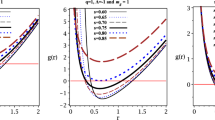Abstract
It is shown that the postulation of a minimum length for the horizons of a black hole leads to lower bounds for the electric charges and magnetic moments of elementary particles. If the minimum length has the order of the Planck scale, these bounds are given, respectively, by the electronic charge and by \(\mu \sim 10^{-21} \mu _B\). The latter implies that the masses of fundamental particles are bounded above by the Planck mass, and that the smallest non-zero neutrino mass is \(m_{\nu } \sim 10^{-2}\)eV. A precise estimation in agreement to the area quantisation of Loop Quantum Gravity predicts a mass for the lightest massive state in concordance with flavor oscillation measurements, and a Barbero–Immirzi parameter in accordance to horizon entropy estimations.
Similar content being viewed by others
Notes
This is valid for Dirac neutrinos in the minimally extended Standard Model with right-handed singlets. Majorana neutrinos do not have magnetic moments.
The last digit in this figure is affected by higher order corrections to (5) that depend on the neutrinos mixing angles and Dirac phase [20]. Using the current best-fits for these quantities [21], we find \(m_{\nu } \approx 8.662\,(8) \times 10^{-3}\, \text {eV}\). Note, however, that higher order loops lead to corrections of the same order.
We are using natural units \(\hbar = c = G = 1\), in which \(l_P = 1\).
References
Dirac, P.A.M.: The Cosmological constants. Nature 139, 323 (1937)
Eddington, A.S.: Fundamental Theory. Cambridge University Press, Cambridge (1946)
Marugán, G.A., Carneiro, S.: Holography and the large number hypothesis. Phys. Rev. D 65, 087303 (2002)
Carneiro, S.: On the vacuum entropy and the cosmological constant. Int. J. Mod. Phys. D 12, 1669 (2003)
’t Hooft, G.: Dimensional reduction in quantum gravity. Conf. Proc. 930308, 284 (1993). (gr-qc/9310026)
Susskind, L.: The World as a hologram, J. Math. Phys. 36, 6377 (1995); Holography and cosmology. W. Fischler and L. Susskind. hep-th/9806039
Easther, R., Lowe, D.: Holography, cosmology and the second law of thermodynamics. Phys. Rev. Lett. 82, 4967 (1999)
Kaloper, N., Linde, A.: Cosmology versus holography. Phys. Rev. D 60, 103509 (1999)
Cohen, A.G., Kaplan, D.B., Nelson, A.E.: Effective field theory, black holes, and the cosmological constant. Phys. Rev. Lett. 82, 4971 (1999)
Tavakol, R., Ellis, G.: On holography and cosmology. Phys. Lett. B 469, 37 (1999)
Bousso, R.: The Holographic principle for general backgrounds. Class. Quantum Gravity 17, 997 (2000)
Ng, Y.J.: From computation to black holes and space-time foam. Phys. Rev. Lett. 86, 2946 (2001)
Padmanabhan, T.: The Holography of gravity encoded in a relation between entropy, horizon area and action for gravity. Gen. Relativ. Gravit. 34, 2029 (2002)
Jacobson, T., Parentani, R.: Horizon entropy. Found. Phys. 33, 323 (2003)
Calmet, X., Carr, B., Winstanley, E.: Quantum Black Holes. Springer, New York (2014)
Gambini, R., Olmedo, J., Pullin, J.: Quantum black holes in loop quantum gravity. Class. Quantum Gravity 31, 095009 (2014)
Perez, A.: Black holes in loop quantum gravity. Rept. Prog. Phys. 80, 126901 (2017)
Ashtekar, A., Olmedo, J., Singh, P.: Quantum transfiguration of Kruskal black holes. Phys. Rev. Lett. 121, 241301 (2018)
Frolov, V.P., Zelnikov, A.: Introduction to Black Hole Physics. Oxford University Press, Oxford (2011)
Giunti, C., Studenikin, A.: Neutrino electromagnetic interactions: a window to new physics. Rev. Mod. Phys. 87, 531 (2015). (Eqs. (4.1)-(4.6))
Esteban, I., et al.: Updated fit to three neutrino mixing: exploring the accelerator-reactor complementarity. JHEP 1701, 087 (2017). (Table 1)
Ashtekar, A., Lewandowski, J.: Background independent quantum gravity: a status report. Class. Quantum Gravity 21, R53 (2004)
Thiemann, T.: Modern Canonical Quantum General Relativity. Cambridge University Press, Cambridge (2008)
Krasnov, K.: Quanta of geometry and rotating black holes. Class. Quantum Gravity 16, L15 (1999)
Bojowald, M.: Angular momentum in loop quantum gravity, gr-qc/0008054
Rovelli, C., Smolin, L.: Discreteness of area and volume in quantum gravity. Nucl. Phys. B442, 593 (1995), Erratum: Nucl. Phys. B456, 753 (1995)
Meissner, K.: Black hole entropy in loop quantum gravity. Class. Quantum Gravity 21, 5245 (2004)
Ghosh, A., Mitra, P.: An improved lower bound on black hole entropy in the quantum geometry approach. Phys. Lett. B 616, 114 (2005)
Corichi, A., Borja, E.F., Diaz-Polo, J.: Quantum geometry and microscopic black hole entropy. Class. Quantum Gravity 24, 243 (2007)
Agulló, I., et al.: Detailed black hole state counting in loop quantum gravity. Phys. Rev. D 82, 084029 (2010)
Mandl, F., Shaw, G.: Quantum Field Theory. Wiley, New York (1984). (chapters 9 and 10)
Acknowledgements
I am thankful to G. A. Mena Marugán for a critical reading and helpful suggestions. My thanks also to J.C. Fabris, R. Gambini, P.C. de Holanda, J. Olmedo, O.L.G. Peres, C. Pigozzo, A. Saa, R. Woodard and J. Zanelli for useful discussions. Work partially supported by CNPq.
Funding
Funding was provided by Conselho Nacional de Desenvolvimento Científico e Tecnológico (Grant No. 307467/2017-1).
Author information
Authors and Affiliations
Corresponding author
Additional information
Publisher's Note
Springer Nature remains neutral with regard to jurisdictional claims in published maps and institutional affiliations.
Rights and permissions
About this article
Cite this article
Carneiro, S. Elementary Charge and Neutrino’s Mass from Planck Length. Found Phys 50, 1376–1381 (2020). https://doi.org/10.1007/s10701-020-00383-z
Received:
Accepted:
Published:
Issue Date:
DOI: https://doi.org/10.1007/s10701-020-00383-z



